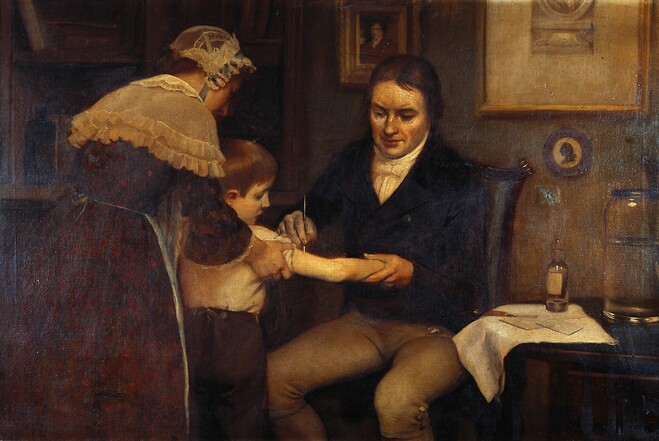The first vaccine derived from cowpox
In the pursuit of a vaccine against Covid-19, the research world has invested in extraordinary efforts and enormous resources. There were no such conditions when the modest Edward Jenner (1749-1823) made his outstanding contribution to an equally horrible plague: the extremely contagious and deadly disease smallpox.
The disease had ravaged Asia for thousands of years before reaching Europe in the 6th century. It spread slowly at first, but by the 18th century, smallpox was the major infectious disease in Europe. Mortality was high, about 20%, and in the 18th century alone, an estimated 60 million Europeans succumbed to the disease.
In Asia, so-called inoculation or variolisation had long been used as a treatment. Matter from the sick was transferred into scratches of the skin of healthy people. When successful, the method produced a milder form of the disease, followed by immunity, but the treatment was risky, and a few per cent of the patients died. The method was introduced in northern Europe in the early 18th century, and one of the people who had himself “variolised” was the Swedish King Gustav III.
Around the same time, the then 13-year-old Edward Jenner, son of a merchant, began as an apprentice to a surgeon outside Bristol. That was where he allegedly heard a milkmaid reveal her folk wisdom: “I will never get smallpox because I have had cowpox. I will never have an ugly, pox marked face.”
Cowpox spreads from cows to humans and usually has a mild course.
For decades, Jenner worked as a doctor, but the milkmaid’s words continued to haunt him. In May 1796, cowpox broke out on a farm in Berkeley and Jenner saw his chance. He vaccinated the 8-year-old farm boy James Phipps with the secretions of an infected milkmaid, and soon cowpox developed on the boy’s arm.
After 6 weeks, Jenner inoculated the boy’s arm with smallpox. There was no reaction – the boy was immune. What is considered the first successful vaccination in history had taken place (although many medical historians today believe that another Briton, Benjamin Jesty, conducted a similar experiment 20 years earlier).
The following year, Jenner wrote to the Royal Society and reported his findings, but he was met with intense scepticism. He “should not risk his reputation” by presenting something so incredible, was their reply. However, Jenner did not give up, but published his own report on his findings. He called his method “vaccination” because cowpox in Latin is vaccinia (from vacce = cow).
The scepticism was soon overcome when the method was proved to work, and demand was huge. Already by 1800, the method had reached most of Europe. Edward Jenner became world-famous, but he was never interested in making money from his discovery. On the contrary, he spent so much time on his vaccination programme that his personal finances suffered. In 1823, he had a stroke and died at his home in Berkeley, aged 73.
Despite the vaccine, it would take a long time and many lives before the disease was eradicated. There was an outbreak in Sweden as late as 1963 when 27 people in Stockholm fell ill, and 4 died. In 1980, after a long struggle, global collaboration and massive vaccination campaigns, the WHO could declare the smallpox virus no longer existed in a wild form, but only in laboratories.
Artikeln är en del av vårt tema om News in English.

 Av
Av